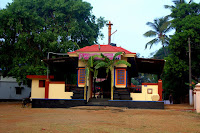The Alathiyoor Perumthrikovil temple is special to its devotees for many reasons. Sri Rama is the Presiding deity here. The daily puja-rituals, offerings by devotees, and the spectacular annual temple festival – all are held in honour of the presiding deity, Sri Rama. However, the devotees popularly refer to this temple, the ‘Hanuman Kavu’ temple. And, in a way, it symbolizes the triumph of the supreme strength of Bhakti of Sri Hanuman as an ideal, which overshadows the presiding deity, Lord sri Rama.
Here, Sri Rama is visualized as the Maryada-Purushothaman- he is separated from his beloved consort, Sita, by the mighty Ravana who has abducted her to Lanka. Sri Rama is seen entrusting Hanuman the possible task of locating the whereabouts of Sita. Sri Rama confides to Hanuman about how to look out for Sita in Lanka. Hanuman, had to cross the vast and formidable sea, that separates Lanka from the main land. Thirty three crore Gods gathered to witness this significant act. It is an act in which the Avatara-purush Sri Rama seeks the assistance of his bhakta, Hanuman. All the Gods bestowed Hanuman with their enormous strength, so that he succeeded in his mission. For Hanuman, this is a very significant moment, and hence, his pre-eminence at Alathiyoor.
The unique posture of Hanuman in the temple
The temple of Sri Hanuman is adjacent to the main temple of Sri Rama. Sri Hanuman stands leaning a little towards the left, to hear his master’s words. Sri Rama is confiding in Hanuman the cue-word ( Abhignana Vaakyam ) that would enable him to gain the confidence of Sita. Hanuman has a mace in his hand. The numerous Gods bestowed their enormous power on Sri Hanuman. He is all set to accomplish his mission, which is seeking the whereabouts of Sita. Here he is the personification of divine strength, confidence, concentration of purpose, Bhakti, and above all humility. He is the symbol of supreme self-sacrifice. He seems to be assuring Sri Rama: “Your wish is my command”. Devotees of Hanuman throng to this temple to make their wishes and be heard by the mighty Hanuman.
There is a platform to commemorate Sri Hanuman’s mighty leap to Lanka over the sea. There is a long granite stone at one end of this platform and it symbolizes the sea. Devotees com running and leap over this long stone. By doing this, auspicious impact is expected especially for the better health and life of children.
The Anjaneya temple was established by sage Vasishta in Alathiyur, Kerala. The temple's history is based on the epic of the Ramayana. In the sanctum sanctorum, Sri Rama appears alone without Mother Sita. Sri Hanuman graces in the other shrine as listening to the Sri Rama telling him how to identify the mother Sita, to help him to spot her without any doubt. Devas contributed all their might to Hanuman to enable him to succeed in his mission. The idol of the Sri Lakshmana is established a little far away, that he would not disturb the privacy between Rama and Hanuman when the former was narrating some past incidents to Hanuman to identify mother Sita.
Sri Hanuman is a staunch follower of the Sri Rama who dedicated his service to Rama only. He expected nothing in return for his services in searching Mother Sita. He was the abode of all the noblest divine qualities coupled with an unparallel physical and mental prowess to conquer any situation of any gravity. But he himself was not aware of his extraordinary capabilities. He never spoke to anybody about his powers but simply felt and said that he was born for the service of Sri Rama. He was only saying that he was the last servant of the lord. The interesting thing to be noted, is that, Sugriva got back his kingdom for the service he rendered to the Lord. Angatha was nominated as the heir-apparent of Kishkinda. Vibishana was crowned as the king of Lanka. Hanuman expected nothing. He respectfully declined to accept the pearl chain offered to him by Mother Sita. Sri Rama could not find anything that would be a fitting reward to him. Rama finally asked him to embrace him and blessed him eternity. Hanuman was born on the new moon day. Worshipping him on this day brings immense benefits to the devotees.
Popular pujas here
Panchasara payasam
Kadalipazham
Thiruvona puja
Thiruvona Oottu
Neivilakku
Avil (rice flakes with jaggery and other ingredients) is the most important present here. The belief is that if one pray for a wish then upon the fulfilment the devotee is supposed to offer this to the temple. This is the most popular puja here and that shows experience and belief of devotees in this temple.
Temple authorities have transformed he temple to use the latest technologies to help devotees pray and do their offerings from anywhere in the world through their website http://www.alathiyoorhanumankavu.in and more and more devotees are using it everyday
- Article contributed by Alathiyoor Perumthrikkovil temple











